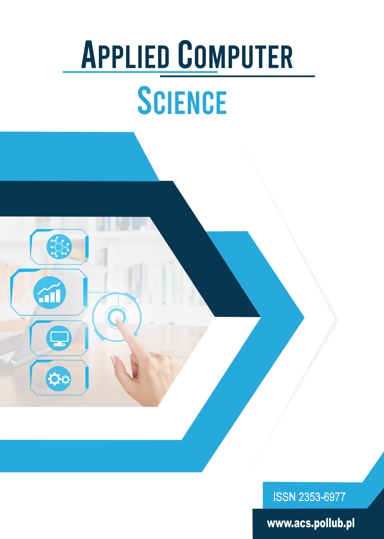REVIEW OF THE DATA MODELING STANDARDS AND DATA MODEL TRANSFORMATION TECHNIQUES
Leszek JASKIERNY
leszekj@agh.edu.plAGH University of Science and Technology, Faculty of Electrical Engineering, Automatics, Computer Science and Biomedical Engineering, Department of Computer Science, (Poland)
Abstract
Manual data transformations that result in high error rates are a big problem in complex integration and data warehouse projects, resulting in poor quality of data and delays in deployment to production. Automation of data transformations can be easily verified by humans; the ability to learn from past decisions allows the creation of metadata that can be leveraged in future mappings. Significant improvement of the quality of data transformations can be achieved, when at least one of the models used in transformation is already analyzed and understood. Over recent decades, particular industries have defined data models that are widely adopted in commercial and open source solutions. Those models (often industry standards, accepted by ISO or other organizations) can be leveraged to increase reuse in integration projects resulting in a) lower project costs and b) faster delivery to production. The goal of this article is to provide a comprehensive review of the practical applications of standardization of data formats. Using use cases from the Financial Services Industry as examples, the author tries to identify the motivations and common elements of particular data formats, and how they can be leveraged in order to automate process of data transformations between the models.
Keywords:
Business standards, Interoperability, Canonical Data Models, Graphs, Graph Databases, Graph TransformationsReferences
ADRM Software. (2018, August 1). Business Area Data Models. Retrieved from http://www.adrm.com/data-model-business-area.html
Google Scholar
Angles, R., & Gutierrez, C. (2008). Survey of graph database models. New York, USA: ACM.
DOI: https://doi.org/10.1145/1322432.1322433
Google Scholar
Bray, T., Paoli, J., Sperberg-McQueen, C. M., Maler, E., & Yergeau, F. (2008). Extensible Markup Language (XML) 1.0 (Fifth Edition). Retrieved from https://www.w3.org/TR/xml
Google Scholar
Cortet, M. (2014). Access to the Account (XS2A): accelerating the API-economy for banks? Retrieved from https://innopay.com/blog/access-to-the-account-xs2a-accelerating-the-apieconomy-for-banks
Google Scholar
Holman, K. (2018). OASIS Universal Business Language (UBL) TC. Retrieved from https://www.oasisopen.org/committees/tc_home.php?wg_abbrev=ubl ISO 20022. (2018, August 1). Universal financial industry message scheme. Retrieved from https://www.iso20022.org
Google Scholar
Kotulski, L. (2013). Rozproszone transformacje grafowe. Kraków, Poland: Wydawnictwo AGH.
Google Scholar
McKnight, W. (2014). IBM Industry Data Models in the Enterprise. Retrieved from https://www01.ibm.com/software/data/industry-models/
Google Scholar
Roman, D. (2006). Canonical Data & Process Models for B2B Integration. Retrieved from http://ceur-ws.org/Vol-170/paper3.pdf
Google Scholar
Skinner, Ch. (2015). How will Banks organise themselves to manage APIs built for PSD2/XS2A?
Google Scholar
Retrieved from http://thefinanser.com/2015/11/how-will-banks-organise-themselves-to-manageapis-built-for-psd2-xs2a.html/
Google Scholar
Sleger, G. (2010). Data Transformation Mapping – Can it be Automated? Retrieved from https://www.cleo.com/blog/data-transformation-mapping-can-it-be-automated
Google Scholar
SWIFT. (2018, August 1). Financial messaging services. Retrieved from https://www.swift.com/aboutus/discover-swift/messaging-standards
Google Scholar
Thompson, H. & Lilley, C. (2014). XML Media Types, RFC 7303. Retrieved from https://tools.ietf.org/html/rfc7303
DOI: https://doi.org/10.17487/rfc7303
Google Scholar
Authors
Leszek JASKIERNYleszekj@agh.edu.pl
AGH University of Science and Technology, Faculty of Electrical Engineering, Automatics, Computer Science and Biomedical Engineering, Department of Computer Science, Poland
Statistics
Abstract views: 342PDF downloads: 50
License

This work is licensed under a Creative Commons Attribution 4.0 International License.
All articles published in Applied Computer Science are open-access and distributed under the terms of the Creative Commons Attribution 4.0 International License.
Similar Articles
- Zakaria KADDARI, Ikram El HACHMI, Jamal BERRICH, Rim AMRANI, Toumi BOUCHENTOUF, EVALUATING LARGE LANGUAGE MODELS FOR MEDICAL INFORMATION EXTRACTION: A COMPARATIVE STUDY OF ZERO-SHOT AND SCHEMA-BASED METHODS , Applied Computer Science: Vol. 20 No. 4 (2024)
- Islam MOHAMED, Mohamed EL-WAKAD, Khaled ABBAS, Mohamed ABOAMER, Nader A. Rahman MOHAMED, PUPIL DIAMETER AND MACHINE LEARNING FOR DEPRESSION DETECTION: A COMPARATIVE STUDY WITH DEEP LEARNING MODELS , Applied Computer Science: Vol. 20 No. 4 (2024)
- Jarosław ZUBRZYCKI, Natalia SMIDOVA, Jakub LITAK, Andrei AUSIYEVICH, NUMERICAL ANALYSIS OF SPINAL LOADS IN SPONDYLOLISTHESIS TREATMENT USING PEDICLE SCREWS – PRELIMINARY RESEARCH , Applied Computer Science: Vol. 13 No. 3 (2017)
- Pannangi Naresh, R. Suguna, IMPLEMENTATION OF DYNAMIC AND FAST MINING ALGORITHMS ON INCREMENTAL DATASETS TO DISCOVER QUALITATIVE RULES , Applied Computer Science: Vol. 17 No. 3 (2021)
- Olufemi Folorunso, Olufemi Akinyede, Kehinde Agbele, ARDP: SIMPLIFIED MACHINE LEARNING PREDICTOR FOR MISSING UNIDIMENSIONAL ACADEMIC RESULTS DATASET , Applied Computer Science: Vol. 19 No. 1 (2023)
- Yehor TATARCHENKO, Volodymyr LYFAR, Halyna TATARCHENKO, INFORMATION MODEL OF SYSTEM OF SUPPORT OF DECISION MAKING DURING MANAGEMENT OF IT COMPANIES , Applied Computer Science: Vol. 16 No. 1 (2020)
- Siti ROHAJAWATI, Hutanti SETYODEWI, Ferryansyah Muji Agustian TRESNANTO, Debora MARIANTHI, Maruli Tua Baja SIHOTANG , KNOWLEDGE MANAGEMENT APPROACH IN COMPARATIVE STUDY OF AIR POLLUTION PREDICTION MODEL , Applied Computer Science: Vol. 20 No. 1 (2024)
- Yakub HOSSAIN, Zannatul FERDOUS, Tanzillah WAHID, Md. Torikur RAHMAN, Uttam Kumar DEY, Mohammad Amanul ISLAM, Enhancing intrusion detection systems: Innovative deep learning approaches using CNN, RNN, DBN and autoencoders for robust network security , Applied Computer Science: Vol. 21 No. 1 (2025)
- Baigo HAMUNA, Sri PUJIYATI, Jonson Lumban GAOL, Totok HESTIRIANOTO, CLASSIFICATION AND PREDICTION OF BENTHIC HABITAT FROM SCIENTIFIC ECHOSOUNDER DATA: APPLICATION OF MACHINE LEARNING ALGORITHMS , Applied Computer Science: Vol. 20 No. 4 (2024)
- Anna MACHROWSKA, Robert KARPIŃSKI, Józef JONAK, Jakub SZABELSKI, NUMERICAL PREDICTION OF THE COMPONENT-RATIO-DEPENDENT COMPRESSIVE STRENGTH OF BONE CEMENT , Applied Computer Science: Vol. 16 No. 3 (2020)
<< < 1 2 3 4 5 6 7 8 9 10 > >>
You may also start an advanced similarity search for this article.








